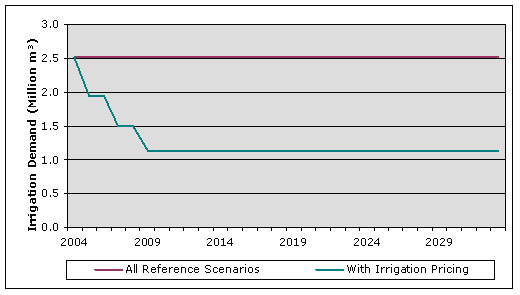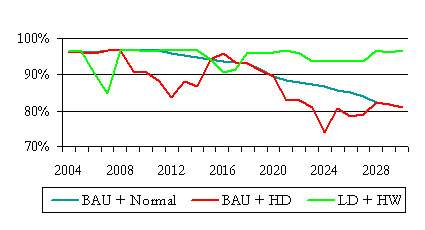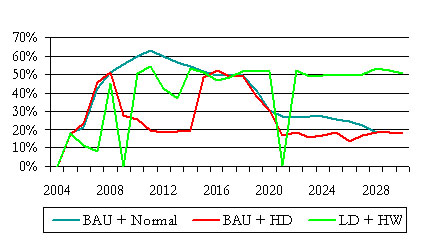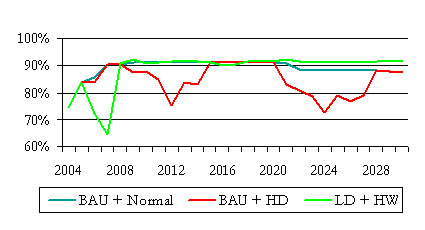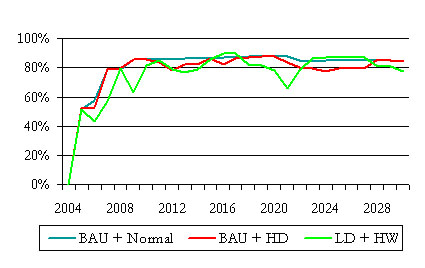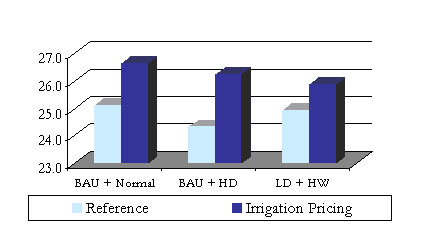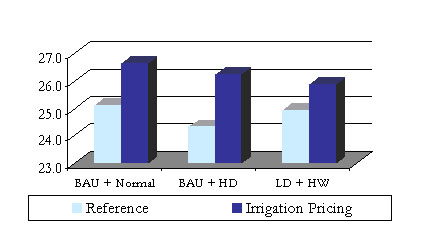
ISSUE 6 |
||||||||||||||||||||||||||||||||||||||||||||||||||||
|
|
|||||||||||||||||||||||||||||||||||||||||||||||||||
Option results |
||||||||||||||||||||||||||||||||||||||||||||||||||||
|
Irrigation demand under the selected pricing scheme is presented in Figure 1. Figure 1. Irrigation demand before and after the implementation of a pricing scheme |
||||||||||||||||||||||||||||||||||||||||||||||||||||
|
|
||||||||||||||||||||||||||||||||||||||||||||||||||||
Effectiveness |
||||||||||||||||||||||||||||||||||||||||||||||||||||
|
As with domestic pricing, irrigation pricing has a significant impact on agricultural demand. The high price increase and the relatively high tentative elasticity assumed lead to a considerable improvement of domestic and irrigation deficits. This improvement is adequate to stabilise the effectiveness to domestic demand coverage up to the year 2010, provided of course that water availability is constant (Figure 2). Similarly, the improvement of domestic deficits reaches a maximum of 62% during the same period (Figure 3). It should be noted that during wet years the option has particularly no effect, since it is during these periods that domestic deficit is at a minimum and no further improvements can be achieved. Figure 2. Percent demand coverage effectiveness of Irrigation Pricing to Domestic use Figure 3. Percent Improvement of deficit in Domestic use with respect to the reference scenarios The impact on the effectiveness to irrigation demand coverage is higher (Figure 4). It reaches approximately 90% under the LD+HW scenario, while under the BAU+Normal scenario it drops at 87% due to the increase of domestic demand. The improvement with respect to each reference case shows a stabilising trend, around 80%. Figure 4. Percent demand coverage effectiveness of Irrigation Pricing to Irrigation use
Figure 5. Percent Improvement of deficit in Irrigation use |
||||||||||||||||||||||||||||||||||||||||||||||||||||
Direct and Environmental Costs |
||||||||||||||||||||||||||||||||||||||||||||||||||||
|
Reduction of irrigation demand results in the augmentation of supply delivered to domestic uses. This in turn, increases the operating costs of the system and leads to an average increase of about 4-8% on direct costs. (Figure 6).
Figure 6. Total direct cost difference of the Irrigation Pricing option The decrease of environmental costs is marginal for the application of irrigation pricing on the BAU+Normal and on the BAU+HD scenaria (Figure 7). However, under the LD+HW, this decrease reaches 4%; the large reduction of irrigation demand leads to a more sustainable exploitation of groundwater resources, limiting groundwater abstractions.
Figure 7. Total environmental cost difference of the Irrigation Pricing option |
||||||||||||||||||||||||||||||||||||||||||||||||||||
